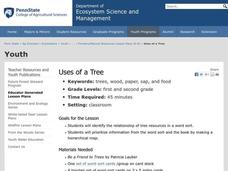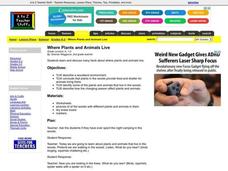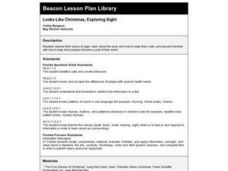Curated OER
Electrical Circuits
Learners explore parallel and series circuits. In this electrical circuit lesson, students investigate the differences between series and parallel circuits. Learners observe the benefits and drawbacks of series and parallel...
Curated OER
All About Birds
Pupils study different kinds of birds, and demonstrate reading comprehension skills, including reading strategies, inference, literal meaning, and critical analysis.
Curated OER
Uses of a Tree
Students identify and explore the resources we use that come from trees. In this reading comprehension lesson, students sort word cards about resources that come from trees into groups based on the type of resource.
Curated OER
Identifying Trees Using Their Leaves in the Summer
Students discover how to identify trees. In this research lesson plan students use dendrology to decipher what a trees classification is and explore each trees traits.
Curated OER
What did T. rex taste like?
Students examine the three domains of life and explain that all living things share a common ancestor. In this paleontology lesson plan students are introduced to the process of illustrating evolutionary relationships.
Curated OER
Exploring Limu Diversity
Young scholars explore limu diversity. In this ocean ecosystem activity, students classify limu according to its physical properties. Young scholars work in small groups to generate scientific observations and sort limu by characteristics.
Curated OER
Where Plants and Animals Live
Learners explore and discuss facts about a woodland environment, the plants and animals that live there, and changing seasons in the woods. They conclude that plants in the woods provide food and shelter for animals living there.
Curated OER
Looks Like Christmas: Exploring Sight
Students participate in various hands-on activities to determine what life is like without the sense of sight.
Curated OER
A Tree Is More than a Street Name
Eighth graders discuss the role of trees as one of the most important natural resources. In groups, they examine how the forests nearby helped to shape their urban city. Using the internet, they research the use of the forest in early...
Curated OER
Plant Life of the Rainforest
Students study pictures of tropical rainforests and discuss its stratified character. Students then work with a partner to make a scale drawing of the rainforest strata.
Curated OER
Bird Feeders
Learners create environmentally friendly art. In this visual arts lesson, students follow the provided instructions to create hanging bird feeders.
Curated OER
How Does Climate Affect Plant Growth?
First graders compare plant samples obtained from two different sites to explore how climate affects plants.
Curated OER
Populations and Ecosystems
Sixth graders examine the factors that influence the stability of ecosystems. They construct a miniature ecosystem in a jar that includes plants, small fish, and snails, record the population changes over a period of four weeks, and...
Curated OER
Tree Hunt
Students identify the common trees of Iowa and make observations while creating a key. In this tree hunt lesson, students write a letter to the Iowa Department of Natural Resources to receive a pamphlet of Common Trees of Iowa. Students...
Curated OER
Archimedes' Principle
Young scholars examine the relationship between density and buoyancy. In this physics lesson students use Archimedes' Principle to complete calculations on buoyancy and a lab activity.
Curated OER
Mold
Young scholars explore mold, the different types and the health risks that they pose. In this mycelium lesson students grow different molds and see which type of foods mold the fastest.
Curated OER
Genetic Engineering
Students examine the advantages and disadvantages of genetic engineering. For this genetics lesson students simulate the genetic engineering of a human insulin gene.
Curated OER
Taking Care of a Baby
Students are introduced to the basics of human development and the critical role of parents in taking care of a newborn.
Curated OER
Taking Care of a Baby
Students explore the basics of human development and the critical role of parents in taking care of a newborn.
Curated OER
The Sounds Of Nature
Second graders investigate the concept of sounds in nature. The sound of a coqui frog is used as an example. They identify species of frogs by listening to the sounds they make. Also, 2nd graders experience and identify other sounds of...
Curated OER
What's The Matter
Students identify and describe the different stages of matter. In groups, the use lego pieces to represent the moving parts of matter. They use the internet to research the meanings of nano, micro and macro sizes. They also use the...
Curated OER
Exploring Texture In the Garden
Students explore the garden environment. In this garden environment lesson, students investigate the needs and parts of a plant. Students discover the differences between fruits and vegetables while creating their own garden.
Curated OER
Bouncing Balls
Students create a polymer ball in the lab. In this chemistry lesson plan, students identify the different properties of the polymer they created. They explain what type of chemical reaction took place.
Curated OER
A Peek at the Past: Gradualism vs. Punctuated Equilibria
Students consider two sets of simulated fossils (caminalcules) that are provided as cutouts. They arrange them on two time scales. One set produces a visual example of gradualism, the other shows punctuated equilibria.
Other popular searches
- Major Branches of Science
- Biological Sciences Branches
- The Branches of Science
- 20 Branches of Science
- 12 Branches of Science
- Three Branches of Science
- All Branches of Science
- Earth Science Branches
- Biological Science Branches
- Science Branches

























